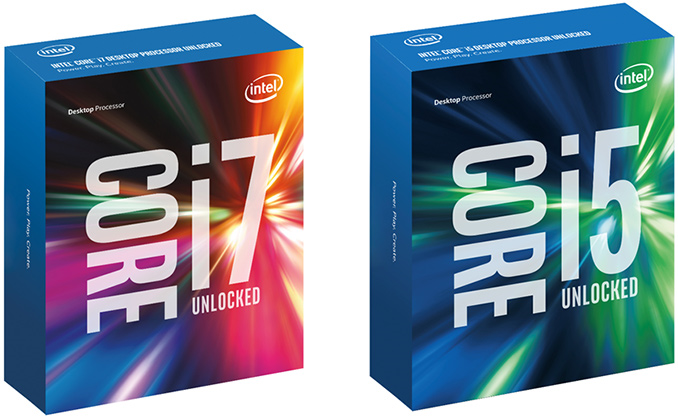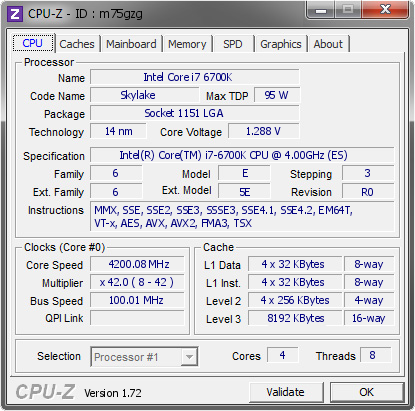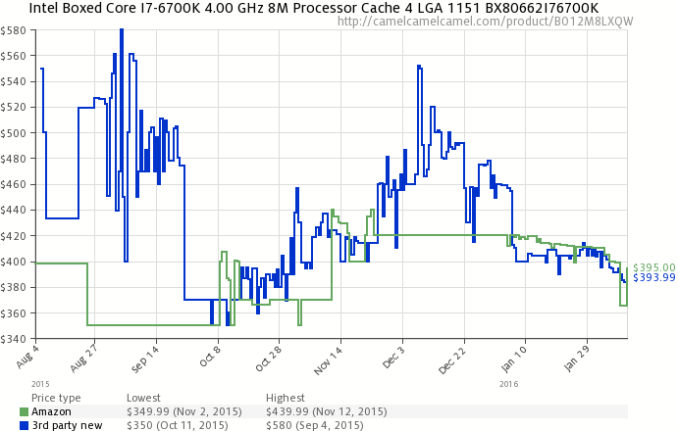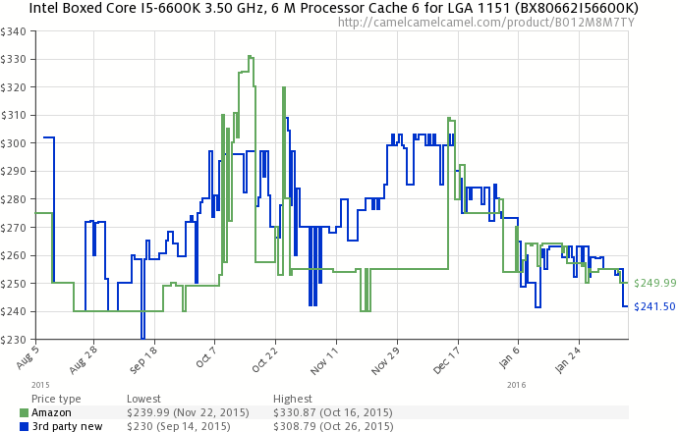Price Check: Intel’s Unlocked Skylake Processors for Desktops Are Getting More Affordable
by Anton Shilov on February 16, 2016 1:00 PM EST
Due to unprecedented demand, Intel’s latest Skylake processors with unlocked multiplier were significantly overpriced late last year. However, it would seem that more units are coming into retail as the popular Core i7-6700K and Core i5-6600K CPUs are becoming more readily available from multiple stores. As a result, actual retail prices of the chips have dropped in the U.S. retail in the recent weeks. Nonetheless, the most powerful Skylake-S is still listed above its suggested retail price.
Supply of Skylake-S Seems To Getting Better
Intel’s top-of-the-range processor for mainstream enthusiasts (before they make the step up to HEDT platforms), the Core i7-6700K (four cores with Hyper-Threading, 4.0 GHz/4.20 GHz, 8 MB cache, Intel HD Graphics 530 core, unlocked multiplier), has an MSRP of $350 according to Intel’s ARK. About six weeks ago, this processor in the US cost more than $420 at some stores, and was frequently in and out of stock of the biggest retailers.
However, this seems to be changing. Amazon currently (2/14) lists the Core i7-6700K for $365 but the chip is not in stock. According to CamelCamelCamel, a price-tracker that monitors Amazon and its partners, the Core i7-6700K was available from Amazon for $365 earlier this week, marking a significant shift in price. PriceZombie, which monitors Newegg, reports that the CPU is in stock and can be purchased for $412. According to NowInStock, the Core i7-6700K is available from multiple retailers but its price remains rather high (e.g., $395 – $412).
The Intel Core i5-6600K (four cores, 3.50 GHz/3.90 GHz, 6 MB cache, Intel HD Graphics 530, unlocked multiplier) is another chip in high demand by enthusiasts. The official price of the boxed version of the CPU is $243, but it was up to $290 in December. At present, both Amazon (CamelCamelCamel) and Newegg (PriceZombie) sell the part for $249 (2/14). Moreover, the Core i5-6600K CPU is readily available from a number of major retailers in the U.S., according to NowInStock.
As it appears, the availability of Intel’s Skylake-S microprocessors has improved since December and it is possible to get all the latest chips from Intel. The Core i7-6700K remains overpriced, it is still more expensive than the Core i7-5820K high-end desktop processor (six cores with Hyper-Threading, 3.30GHz/3.60 GHz, 15 MB cache, unlocked multiplier), which can be purchased for $379 – $385 in the U.S. Since the difference between the i7-6700K and the i7-5820K is now miniscule, for many people it makes no sense to invest in a HEDT platform, which involves purchase of an expensive Intel X99 motherboard and at least four memory modules.
Intel Boosts Shipments of 14nm Chips
According to Intel, starting from November, half of its client chips were made using 14 nm fabrication technology, which was a big breakthrough since the latest manufacturing process was a tough nut to crack for the chip giant. Intel had to delay mass production of its 14 nm CPUs from late 2013 to the second half of 2014 due to defect densities. The ramp up of mass production may mean that the defect densities are getting lower.
“As of November, 14nm products made up more than 50% of the client computing volume,” said Brian Krzanich, chief executive of Intel, during the Q4 2015 Earnings Conference Call with investors and financial analysts.
Starting from the third quarter of fiscal 2015, Intel has been using its Fab 24 manufacturing facility in Leixlip, Ireland, to produce its chips using 14 nm fabrication process. Earlier Intel produced its chips using this technology only in its D1D, D1C and D1X fabs in Hillsboro, Oregon. As Intel ramps up production at Fab 24, shipments of its latest microprocessors are growing. The chip giant does not readily disclose what exactly it produces and where, so it is impossible to say for sure that supply of higher-end Skylake-S models is gradually improving because of the Fab 24 ramp, although given what we do know it seems more than likely.
Nonetheless, it is evident that supply of Intel’s unlocked processors has gotten better, just like the share of Broadwell and Skylake CPUs has gotten higher in Intel’s shipments. At present Intel offers various 14 nm chips, including processors for desktops and laptops featuring Broadwell and Skylake micro-architectures, SoCs for tablets and notebooks based on Skylake and Airmont micro-architectures and so on. The company also plans to start shipments of its new Xeon processors featuring Broadwell-EP cores (as well as new Broadwell-E HEDT offerings) in the first half of the year.
Intel: Demand for Core i7 Sets Records
It is interesting to note that demand for higher-end Core i7 and unlocked processors set a record in fiscal year 2015, according to Intel. Strong demand for CPUs for gamers and overclockers partly explains deficit of Intel’s unlocked Skylake-S chips late last year.
“For the year, high-end Core i7 microprocessors and our K SKUs for gaming, both set all-time volume records, leading to our rich product mix,” Mr. Krzanich told investors and analysts.
If demand for high-end SKUs is so high, it is not surprising that Intel is allegedly trying to limit overclocking to its Core i7 Extreme (HEDT) as well as Core i7/i5-K product lineups. There is simply no need for the company to enable overclocking for lower-end models if users are eager to buy higher-end parts. Unfortunately, it is also evident that demand for the high-end Core i7-6700K is still high enough to drive the price up at the retailer.
Relevant Reading
Skylake-K Review: Core i7-6700K and Core i5-6600K - CPU Review
Comparison between the i7-6700K and i7-2600K in Bench - CPU Comparison
Overclocking Performance Mini-Test to 4.8 GHz - Overclocking
Skylake Architecture Analysis - Architecture
Non-K BCLK Overclocking is Being Removed - Overclocking Update













54 Comments
View All Comments
nmm - Tuesday, February 16, 2016 - link
My guess is that the wave of 2600k owners finally breaking down and upgrading would be a good explanation for the uptick in i7 sales. While the 6700k isn't a huge upgrade from the 2600k, it is measurably better, plus the availability of things like USB-C, NVME and even PCIE 3.0 offer a good enough reason to finally update those 4+ year old high-end systems. Imagine what sales would be like if they managed 25% speed boosts per generation instead of per 4 generations >.>fackamato - Tuesday, February 16, 2016 - link
2600k @ 4Ghz + GTX 980 + Samsung 840 Pro here, I don't see any reason to upgrade, yet!Perhaps next or next-next gen.
LordanSS - Tuesday, February 16, 2016 - link
3770k here. Going for next-next gen myself, not enough of a performance boost yet in most of my usage scenarios. =/stun - Friday, February 26, 2016 - link
I agree. I have 3770K with GTX 980 Ti, 32GB RAM, and Samsung 850 Pro 1TB SSD.As of right now, we will have to wait at least 2 or 3 more years for a worthy upgrade.
I am going to wait till the following techs become available.
(1) PCIe 4.0
(2) Truly 4K (or maybe even 5K) capable graphics cards (probably Nvidia Volta or AMD 500/600 series)
(3) Intel Canonlake or the Ice Lake
Matthmaroo - Tuesday, February 16, 2016 - link
Z68 , so you have no need for usb 3 , sata6 , nvme , pcie 3I just got nvme is fucking amazing
jas340 - Tuesday, February 16, 2016 - link
I agree. If desktop computers were only about the CPU, then there would be no need to upgrade very often. The chipset on the MB's is where the action is. DDR4, 3.1 USB, PCI 3.0, M.2 NVMe, Displayport. etc. That's were the advancement is coming from. CPU's seem to be stagnating the last 5 years or so. SATA SSD have been stagnant also for 3 years or so. I believe 4k monitors and/ or 2k monitors at 144hz will need newer boards to maximize performance. PCI 2.0, SATA SSD, and DVI-D are moving into the past. I would be great if a 2500K would plug into a Z170 MB but Intel could not make billions upon billions if that were the case.Vatharian - Wednesday, February 17, 2016 - link
USB 3.0 is available on 6x chipsets. USB 3.1 can be enabled by pcie device, but benefits from it are very small, until you have hardware. There is literatlly a dozen devices with support for full 3.1.PCIe 2.0 isn't that much of a bottleneck. It's a tradeoff - I could drop in newer platform to enable more performance from gpu, but cpu will limit me - find me newer that can do 5.2 GHz.
NVMe works on anything that has pci-express with sufficient bandwidth, just not as a boot drive. And even then it can be used as system drive (in Linux I can load up initrd from another device, I suppose I could do same in Windows). What turns me off from newer platform is drastic reduction in number of SATA connectors. With small capacities of SSD it makes perfect sense to pile them on, yet to do so I have to spare precious pcie lanes for a controller.
Samus - Wednesday, February 17, 2016 - link
I finally upgraded my i7-920 built in 2008 to a i7-4770k in 2014, based on the promise that platform would be supported through the next generation of ships (Z87) which it wasn't. Even Z97 didn't support beyond Haswell (unless you really consider Broadwell a realistic upgrade...it wasn't, desktop variants were basically ghosts.)Just super pissed off at Intel. If I had known how Skylake would turn out, demanding yet a new platform, and how much they botched Haswell, with FIVR, very poor thermal performance and a dead-end platform, I would have done what all the smart people obviously did (based on the sales of Skylake) and waited another 15 months. I invested hundreds in a motherboard, processor, and DDR3 memory, thinking I'd be able to upgrade the CPU at least once. I can't think of a single Intel platform, ever, that only supported ONE GENERATION of CPU.
hurrakan - Friday, February 19, 2016 - link
Doesn't have to be Z68. I have 2600K on Z77, which includes native USB 3.0 and PCIE 3.0AnnonymousCoward - Sunday, February 21, 2016 - link
> I just got nvme is fucking amazingYou must love benchmarking, because the 950 Pro has insignificant real world gain for most types of usage.